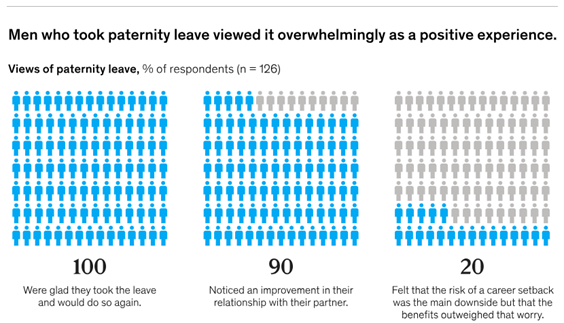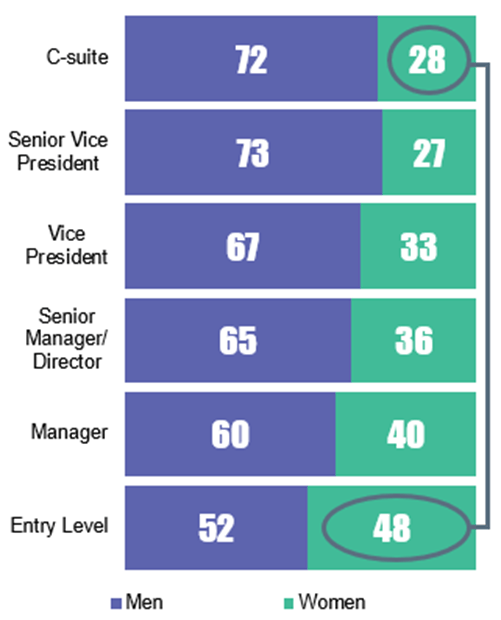Key Points
- We believe that expanding parental leave policies to include fathers/non-gestational caregivers could unleash a slew of positive effects for both women and men and the organizations that employ them.
- Companies with greater gender diversity are likely to see higher returns and enhanced profitability; they may be rewarded with higher multiples and report greater employee satisfaction with less turnover.1, 2, 3, 4
- As investors, we believe companies that offer attractive family-leave benefits for both primary and secondary caregivers could benefit financially over time.
Efforts to foster gender equity in the workplace have largely focused on developing corporate policies that better support women, and for good reason. Given the breadth and depth of data on the financial benefits that gender diversity can bring organizations—including greater return on equity (ROE), return on assets (ROA) and profitability—these moves make sense economically.5, 6, 7 However, if companies continue to center their efforts on women alone, we believe they may run the risk of overlooking some potentially impactful solutions.
In our view, by widening the scope of these discussions to include both men and women, particularly in the context of evolving social and cultural norms, organizations may find better ways of boosting gender diversity in the workplace. Take, for instance, paid parental leave. We believe that expanding parental leave policies to include fathers/non-gestational caregivers could unleash a slew of positive effects for both women and men and the organizations that employ them.
Why Now?
Burnout is a risk for anyone in the workforce with a heavy workload, especially for those who struggle to balance work demands with responsibilities at home. Women are particularly exposed to this risk, as many continue to bear the brunt of household chores and caregiving responsibilities. The global pandemic magnified the domestic workload imbalance as unpaid caregiving demands rose substantially during this period and effects trickled into the labor market. In 2021, over one in four women across the United States and Canada considered stepping back in their careers or exiting the workforce altogether. Just two years later, in 2023, the talent pipeline signaled a deceleration of progress for women, especially in middle management.8
Broken Ladder to Leadership
2023 Gender Representation in Corporate Role
Today, a far greater number of women are pursuing careers than in previous generations, yet women remain underrepresented across the corporate ladder.9 The workforce has changed and continues to evolve, but the legal and corporate systems in place to support employees have yet to catch up.
While the fallout in female participation/upward mobility in middle management is an undeniable setback for women, there are broader organizational implications to consider as well. These include potential impacts to the financial health of the companies that employ them, particularly as alignment in sentiment across male and female employees has been shown to affect company performance and future financial security.10 To achieve and maintain more gender-balanced workforces and management teams, we believe organizations should evaluate their legacy employee-support models, as the systems currently in place may lead to unintended outcomes.
Supporting Modern Parenthood
In our view, it may be worthwhile for companies to consider a more gender-balanced view of parental leave. A growing number of countries and businesses are expanding the scope of eligibility for their parental-leave policies to include new fathers and non-gestational caregivers. In this context, the percentage of first-time fathers taking time off of work to bond with their children and assist with caregiving has grown substantially, from 7.5% in 1975 to 66.5% in 2019.11 Over the last five years, paternity-leave-associated work absences have increased even further, up 183% from 2018 to 2023.12 We believe this is a constructive trend that could yield a myriad of evidence-based personal, economic and organizational benefits.
Clear Benefits for Mothers
There are documented benefits for women on expanding parental leave to include fathers and partners. Mothers may see future earnings rise, parents may choose to divide future household responsibilities more equally, and people may find that attitudes and perceptions around parental leave improve overall.
Research has found that spousal parental leave has a positive impact on future earnings potential for mothers. One study—which followed 9,000 families and examined parental pay one year before childbirth and approximately four years afterward—found that maternal earnings rose by about 7% for every month the father took of parental leave.13 Researchers found that the effects were even greater if the father took a “non-holiday” paternity leave, or parental leave during non-summer months.14 Comparing outcomes across studies can be tricky; however, we believe it is worthwhile to consider these findings alongside those of a second project—a 30-year longitudinal study from the University of Massachusetts that identified a “motherhood penalty,” or a 4% earnings decline, following the birth of each child.15
With respect to household responsibilities, paternity leave can also lead to a more equitable distribution of future tasks at home. Research has shown that paternity leave can sway how parents choose to allocate resources to childcare, domestic work and paid work in later years.16 When dads take leave, particularly when they believe they have both the ability and the acceptance from managers and colleagues to do so, it reduces the pressure on women to assume all childcare responsibilities.
Finally, when fathers and non-gestational partners take leave, it can have a spillover effect on attitudes toward maternity leave, helping to destigmatize the process for women as well. When fathers and partners decline their benefits, or if the opportunity for them to take parental leave is not on the table, the professional and economic setbacks of having children land squarely on the mothers’ shoulders.17
Potential Gains Across the Board
Following on, and potentially resulting from, the positive effects noted above, data suggests that paternity leave may boost parents’ relationship stability. When fathers take parental leave, it may indicate that they are more dedicated to family life, which can ease the caregiving workload for mothers and improve overall parental relationships.18 Additionally, men who spend time caring for their children report feeling a greater sense of happiness and fulfillment. Simultaneously, many new fathers also found that they had a renewed appreciation for their workplaces.19 Grateful for the opportunity to take time off and for the support of employers and peers, new dads reported feeling energized and more motivated after taking leave. They also reported an increase in productivity and efficiency at work through a reexamination of their priorities and time-management strategies, in addition to a stronger allegiance to their organizations.20

From an organizational perspective, parental leave and flexible working policies are key draws for employees and incentives that employees cite for staying with their employers. Both men and women consider workplace flexibility as a top employee benefit, second only to health care and vital to the success of their companies.21 Employee turnover is expensive, involving both quantifiable hard costs, such as salary and benefits, and harder-to-pinpoint soft costs, such as the loss of productivity and time spent training new employees. For companies, investing in talent pipelines and reducing undesired turnover are critical to organizational success.22
The Current State of Paternity Leave
Despite the potential for personal, economic and organizational benefits, men are still allotted only a fraction of the paid leave offered to women, and those with access tend to utilize only a portion of that.23, 24, 25 Only 21% of men in the US have access to paid paternity leave, and of those only about 60% take their full paid leave.26, 27 While perceptions are changing, stereotypes persist, and this can make it difficult for men to fully accept and utilize these benefits. Concerns regarding perceived social scrutiny, implications to career trajectories and impact on earnings contribute to these statistics.28 As with women, population studies have shown a decline in earnings associated with every month of paternity leave taken.29
Raising the Bar to Drive Economic Progress
In our view, modernizing parental leave is one tool that could help drive a more gender-balanced economy—one that could improve workforce productivity. This includes offering family-leave benefits to both primary and secondary caregivers. We believe updates to the US regulatory framework could help facilitate these positive changes.
Currently, there is no US national mandate that requires employers to offer paid parental leave, and only 13 US states have passed family and medical leave laws.30 In comparison, 90 out of 187 countries worldwide already offer government-mandated paternity leave.31, 32 If the US were to follow suit, bringing US parental-leave policies in line with global peer standards, the regulation could help support private efforts to address the gender-equity gap, meet the needs of workforces and invest in future talent pipelines.
In 2004, California enacted a paid family leave policy for both men and women, presenting a helpful case study for states and/or companies considering the same. In a survey conducted, 91% of the state’s participating employers reported that this policy had either a positive or neutral effect on employee performance and company profitability.33 In our view, paid family leave can be a powerful incentive to attract and retain talent. Expanding policies to include men can also foster gender equity in the workforce, which can lead to greater corporate success.34
We believe that supporting changing cultural norms could also benefit economic progress. In addition to embracing parental leave, more men today are choosing to take career breaks to become primary caregivers.35 Reentering the workforce can be challenging for anyone, irrespective of gender, and cultural stereotypes can make it even more challenging for men. In our view, organizations that pass over these candidates are discounting pools of relevant talent.
Conclusion
We believe that enabling working parents to choose how to balance careers with caregiving responsibilities could optimize personal and economic success as well as contribute to closing gender-equity gaps in the workplace. The corporate benefits of greater gender diversity are supported by existing data. Companies with greater gender diversity see higher returns and enhanced profitability; they are rewarded with higher multiples and report greater employee satisfaction with less turnover.36, 37, 38, 39 If organizations make the effort to understand and provide the types of benefits that their employees prefer, particularly those that support work-life balance, we believe they could see lower employee turnover and higher rates of productivity. As investors, we believe companies that offer attractive family-leave benefits for both primary and secondary caregivers could benefit financially over time.
In our investment approach, we apply a framework that incorporates an assessment of corporate practices, and the impact of those practices on gender representation and internal corporate culture. We believe there is economic value in investing with a gender lens. In our view, investing in companies that are similarly aligned in promoting a gender-equitable environment could drive financial returns.
[1] Bank of America, US Equity & Quant Strategy data. Published March 2023
[2] McKinsey & Company. March 5, 2021. https://www.mckinsey.com/capabilities/people-and-organizational-performance/our-insights/a-fresh-look-at-paternity-leave-why-the-benefits-extend-beyond-the-personal
[3] The Pipeline. December 7, 2022. https://execpipeline.com/media/ybjfp51b/the-pipeline-women-count-report-2022.pdf
[4] Glassdoor. September 2020. https://b2b-assets.glassdoor.com/glassdoor-diversity-inclusion-workplace-survey.pdf
[5] Bank of America, US Equity & Quant Strategy data. Published March 2023
[6] BlackRock. November 2023. https://www.blackrock.com/corporate/literature/whitepaper/lifting-financial-performance-by-investing-in-women.pdf
[7] The Pipeline. December 7, 2022. https://execpipeline.com/media/ybjfp51b/the-pipeline-women-count-report-2022.pdf
[8] McKinsey & Company, “Women in the Workplace 2023.” October 5, 2023. https://www.mckinsey.com/featured-insights/diversity-and-inclusion/women-in-the-workplace
[9] McKinsey & Company, “Women in the Workplace 2023.” October 5, 2023. https://www.mckinsey.com/featured-insights/diversity-and-inclusion/women-in-the-workplace
[10] Pensions & Investments. August 12, 2022. https://www.pionline.com/industry-voices/commentary-mind-gap-connection-between-gender-alignment-and-performance
[11] US Census Bureau. September 16, 2021. https://www.census.gov/library/stories/2021/09/two-thirds-recent-first-time-fathers-took-time-off-after-birth.html
[12] The Wall Street Journal. April 8, 2023. https://www.wsj.com/articles/more-workers-take-parental-leave-as-states-employers-expand-eligibility-8eaf8e3a
[13] McKinsey & Company. March 5, 2021. https://www.mckinsey.com/capabilities/people-and-organizational-performance/our-insights/a-fresh-look-at-paternity-leave-why-the-benefits-extend-beyond-the-personal
[14] Institute for Labour Market Policy Evaluation (IFAU), Swedish Ministry of Employment. March 22, 2010. https://www.ifau.se/globalassets/pdf/se/2010/wp10-4-The-effect-of-own-and-spousal-parental-leave-on-earnings.pdf
[15] The Wall Street Journal. September 28, 2018. https://www.wsj.com/articles/want-equality-make-new-dads-stay-home-1538151219
[16] McKinsey & Company. March 5, 2021. https://www.mckinsey.com/capabilities/people-and-organizational-performance/our-insights/a-fresh-look-at-paternity-leave-why-the-benefits-extend-beyond-the-personal
[17] The Wall Street Journal. Updated December 18, 2023. https://www.wsj.com/lifestyle/workplace/it-isnt-just-about-bonding-giving-up-paternity-leave-costs-you-money-cd2f949a?mod=Searchresults_pos1&page=1
[18] McKinsey & Company. March 5, 2021. https://www.mckinsey.com/capabilities/people-and-organizational-performance/our-insights/a-fresh-look-at-paternity-leave-why-the-benefits-extend-beyond-the-personal
[19] McKinsey & Company. March 5, 2021. https://www.mckinsey.com/capabilities/people-and-organizational-performance/our-insights/a-fresh-look-at-paternity-leave-why-the-benefits-extend-beyond-the-personal
[20] McKinsey & Company. March 5, 2021. https://www.mckinsey.com/capabilities/people-and-organizational-performance/our-insights/a-fresh-look-at-paternity-leave-why-the-benefits-extend-beyond-the-personal
[21] McKinsey & Company. October 5, 2023. https://www.mckinsey.com/featured-insights/diversity-and-inclusion/women-in-the-workplace
[22] Society for Human Resource Management (SHRM). February 23, 2019. https://www.shrm.org/topics-tools/news/all-things-work/to-to-hold
[23] United States Census Bureau. September 16, 2021. https://www.census.gov/library/stories/2021/09/two-thirds-recent-first-time-fathers-took-time-off-after-birth.html
[24] Boston College Center for Work and Family. October 31, 2019. https://www.bc.edu/content/dam/files/centers/cwf/research/publications/researchreports/Expanded%20Paid%20Parental%20Leave-%20Study%20Findings%20FINAL%2010-31-19.pdf
[25] The Wall Street Journal. June 12, 2013. https://www.wsj.com/articles/SB10001424127887324049504578541633708283670
[26] Great Place to Work. March 1, 2023. https://www.greatplacetowork.com/resources/blog/how-competitive-is-your-companys-paid-parental-leave#:~:text=In%20the%20U.S.%20parents%20are,paid%20paternity%20leave%20through%20employers.
[27] Boston College Center for Work and Family. October 31, 2019. https://www.bc.edu/content/dam/files/centers/cwf/research/publications/researchreports/Expanded%20Paid%20Parental%20Leave-%20Study%20Findings%20FINAL%2010-31-19.pdf
[28] Institute for Labour Market Policy Evaluation (IFAU), Swedish Ministry of Employment. March 22, 2010. https://www.ifau.se/globalassets/pdf/se/2010/wp10-4-The-effect-of-own-and-spousal-parental-leave-on-earnings.pdf
[29] Demography. October 18, 2013. https://read.dukeupress.edu/demography/article/50/6/2255/169608/The-Impact-of-Paternity-Leave-on-Fathers-Future
[30] Center for American Progress. January 17, 2024. https://www.americanprogress.org/article/the-state-of-paid-family-and-medical-leave-in-the-u-s-in-2024/
[31] McKinsey & Company. March 5, 2021. https://www.mckinsey.com/capabilities/people-and-organizational-performance/our-insights/a-fresh-look-at-paternity-leave-why-the-benefits-extend-beyond-the-personal
[32] Bipartisan Policy Center. March 1, 2022. https://bipartisanpolicy.org/explainer/paid-family-leave-across-oecd-countries/
[33] Family Values @ Work. January 11, 2011. https://familyvaluesatwork.org/first-ever-study-of-californias-paid-family-leave-system-finds-widespread-approval-from-businesses-and-employees-across-the-state/
[34] The Wall Street Journal. September 28, 2018. https://www.wsj.com/articles/want-equality-make-new-dads-stay-home-1538151219
[35] Pew Research Center. August 3, 2023. https://www.pewresearch.org/short-reads/2023/08/03/almost-1-in-5-stay-at-home-parents-in-the-us-are-dads/
[36] Bank of America, US Equity & Quant Strategy data. Published March 2023
[37] McKinsey & Company. March 5, 2021. https://www.mckinsey.com/capabilities/people-and-organizational-performance/our-insights/a-fresh-look-at-paternity-leave-why-the-benefits-extend-beyond-the-personal
[38] The Pipeline. December 7, 2022. https://execpipeline.com/media/ybjfp51b/the-pipeline-women-count-report-2022.pdf
[39] Glassdoor. September 2020. https://b2b-assets.glassdoor.com/glassdoor-diversity-inclusion-workplace-survey.pdf
PAST PERFORMANCE IS NOT NECESSARILY INDICATIVE OF FUTURE RESULTS. Any reference to a specific security, country or sector should not be construed as a recommendation to buy or sell this security, country or sector. Please note that strategy holdings and positioning are subject to change without notice. MAR005864 Exp 02/29. For additional Important Information, click on the link below.
Important information
For Institutional Clients Only. Issued by Newton Investment Management North America LLC ("NIMNA" or the "Firm"). NIMNA is a registered investment adviser with the US Securities and Exchange Commission ("SEC") and subsidiary of The Bank of New York Mellon Corporation ("BNY Mellon"). The Firm was established in 2021, comprised of equity and multi-asset teams from an affiliate, Mellon Investments Corporation. The Firm is part of the group of affiliated companies that individually or collectively provide investment advisory services under the brand "Newton" or "Newton Investment Management". Newton currently includes NIMNA and Newton Investment Management Ltd ("NIM") and Newton Investment Management Japan Limited ("NIMJ").
Material in this publication is for general information only. The opinions expressed in this document are those of Newton and should not be construed as investment advice or recommendations for any purchase or sale of any specific security or commodity. Certain information contained herein is based on outside sources believed to be reliable, but its accuracy is not guaranteed.
Statements are current as of the date of the material only. Any forward-looking statements speak only as of the date they are made, and are subject to numerous assumptions, risks, and uncertainties, which change over time. Actual results could differ materially from those anticipated in forward-looking statements. No investment strategy or risk management technique can guarantee returns or eliminate risk in any market environment and past performance is no indication of future performance.
Information about the indices shown here is provided to allow for comparison of the performance of the strategy to that of certain well-known and widely recognized indices. There is no representation that such index is an appropriate benchmark for such comparison.
This material (or any portion thereof) may not be copied or distributed without Newton’s prior written approval.







